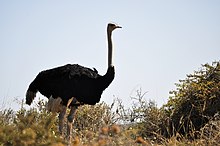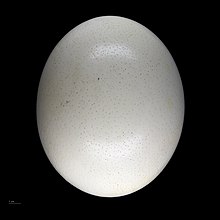Ostrich
| Ostrich | |
|---|---|

| |
| Struthio camelus australis in the West Coast National Park | |
| Scientific classification | |
| Kingdom: | Animalia |
| Phylum: | Chordata |
| Class: | Aves |
| Order: | Struthioniformes |
| Family: | Struthionidae |
| Genus: | Struthio Linnaeus, 1758[1] |
| Type species | |
| Struthio camelus Linnaeus, 1758
| |
| Species | |
|
†Struthio coppensi | |
| Synonyms | |
|
Palaeostruthio Burchak-Abramovich 1953 | |
Struthio is a genus of bird in the order Struthioniformes. There are two living species, the common ostrich and the Somali ostrich.
History[edit]
The genus Struthio was first described by Carl Linnaeus in 1758. The genus was used by Linnaeus and other early taxonomists to include the emu, rhea and cassowary, until they each were placed in their own genera.[1] The Somali ostrich (Struthio molybdophanes) has recently become recognized as a separate species by most authorities, while others are still reviewing the evidence.[2][3]
Evolution[edit]

The earliest fossils of ostrich-like birds are Paleocene taxa from Europe.[4] Palaeotis and Remiornis from the Middle Eocene and unspecified ratite remains are known from the Eocene and Oligocene of Europe and Africa. These may have been early relatives of the ostriches, but their status is questionable, and they may in fact represent multiple lineages of flightless paleognaths.[4][5]
The earliest fossils from this genus are from the early Miocene (20–25 mya), and are from Africa, so it is proposed that they originated there. Then by the middle to late Miocene (5–13 mya) they had spread to Eurasia.[6] By about 12 mya they had evolved into the larger size of which we are familiar. By this time they had spread to Mongolia and later southern Africa.[7] While the relationship of the African fossil species is comparatively straightforward, many Asian species of ostrich have been described from fragmentary remains, and their interrelationships and how they relate to the African ostriches are confusing. In China, ostriches are known to have become extinct only around or even after the end of the last ice age; images of ostriches have been found there on prehistoric pottery and petroglyphs.[8][9][10]
Struthio ostriches once co-existed with another lineage of flightless didactyl birds, the eogruids. Though Olson 1985 classified these birds as stem-ostriches, they are otherwise universally considered to be related to cranes, any similarities being the result of convergent evolution. Competition from ostriches has been suggested to have caused the extinction of the eogruids,[11][12] though this has never been tested and both groups do co-exist in some sites.[13]
Species[edit]
There are nine known species from this genus, of which seven are extinct. Three additional species, S. pannonicus, S. dmanisensis (the giant ostrich), and S. transcaucasicus, were transferred to the genus Pachystruthio in 2019.[14] Several additional fossil forms are ichnotaxa (that is, classified according to the organism's trace fossils such as footprints rather than its body) and their association with those described from distinctive bones is contentious and in need of revision pending more good material.[15]
The species are:
- †Struthio coppensi (Early Miocene of Elizabethfeld, Namibia)
- †Struthio linxiaensis (Liushu Late Miocene of Yangwapuzijifang, China)
- †Struthio orlovi (Late Miocene of Moldavia)
- †Struthio karingarabensis (Late Miocene – Early Pliocene of SW and CE Africa) – oospecies(?)
- †Struthio kakesiensis (Laetolil Early Pliocene of Laetoli, Tanzania) – oospecies
- †Struthio wimani (Early Pliocene of China and Mongolia)
- †Struthio daberasensis (Early – Middle Pliocene of Namibia) – oospecies
- †Struthio brachydactylus (Pliocene of Ukraine)
- †Struthio chersonensis (Pliocene of SE Europe to WC Asia) – oospecies
- †Struthio asiaticus, Asian ostrich (Early Pliocene – Late Pleistocene of Central Asia to China ?and Morocco)
- †Struthio oldawayi (Early Pleistocene of Tanzania) – probably subspecies of S. camelus
- †Struthio anderssoni – in N China/Mongolia[9][16] oospecies(?)
- Struthio camelus, common ostrich
- Struthio molybdophanes, Somali ostrich
Footnotes[edit]
- ^ a b Gray, G.R. (1855)
- ^ Gil, F. & Donsker D. (2012)
- ^ Birdlife International (2012)
- ^ a b Buffetaut, E.; Angst, D. (2014). "Stratigraphic distribution of large flightless birds in the Palaeogene of Europe and its palaeobiological and palaeogeographical implications". Earth-Science Reviews. 138: 394–408. doi:10.1016/j.earscirev.2014.07.001.
- ^ Agnolin et al, Unexpected diversity of ratites (Aves, Palaeognathae) in the early Cenozoic of South America: palaeobiogeographical implications. Alcheringa An Australasian Journal of Palaeontology · July 2016 DOI: 10.1080/03115518.2016.1184898
- ^ Hou, L. et al. (2005)
- ^ Davies, S.J.J.F. (2003)
- ^ Doar, B.G. (2007) "Genitalia, Totems and Painted Pottery: New Ceramic Discoveries in Gansu and Surrounding Areas". China Heritage Quarterly
- ^ a b Janz, Lisa; et al. (2009). "Dating North Asian surface assemblages with ostrich eggshell: Implications for palaeoecology and extirpation". Journal of Archaeological Science. 36 (9): 1982–1989. doi:10.1016/j.jas.2009.05.012.
- ^ Andersson, J. G. (1923). "Essays on the cenozoic of northern China". Memoirs of the Geological Survey of China (Peking), Series A. 3: 1–152 (53–77).
- ^ Kurochkin, E.N. (1976). "A survey of the Paleogene birds of Asia". Smithsonian Contributions to Paleobiology. 27: 75–86.
- ^ Kurochkin, E.N. (1981). "New representatives and evolution of two archaic gruiform families in Eurasia". Transactions of the Soviet-Mongolian Paleontological Expedition. 15: 59–85.
- ^ Zelenkov, Nikita; Boev, Zlatozar; Lazaridis, Georgios (2015). "A large ergilornithine (Aves, Gruiformes) from the Late Miocene of the Balkan Peninsula". Paläontologische Zeitschrift. 90: 145–151. doi:10.1007/s12542-015-0279-z.
- ^ Zelenkov, N. V.; Lavrov, A. V.; Startsev, D. B.; Vislobokova, I. A.; Lopatin, A. V. (2019). "A giant early Pleistocene bird from eastern Europe: unexpected component of terrestrial faunas at the time of early Homo arrival". Journal of Vertebrate Paleontology: e1605521. doi:10.1080/02724634.2019.1605521.
- ^ Bibi, Faysal; Shabel, Alan B.; Kraatz, Brian P.; Stidham, Thomas A. (2006). "New Fossil Ratite (Aves: Palaeognathae) Eggshell Discoveries from the Late Miocene Baynunah Foramation of the United Arab Emirates, Arabian Peninsula" (PDF). Palaeontologia Electronica. 9 (1): 2A. ISSN 1094-8074.
- ^ J. G. Andersson, Essays on the cenozoic of northern China. Memoirs of the Geological Survey of China (Peking), Series A, No. 3 (1923), pp. 1–152, especially pp. 53–77: "On the occurrence of fossil remains of Struthionidae in China."; and J. G. Andersson, Research into the prehistory of the Chinese. Bulletin of the Museum of Far Eastern Antiquities 15 (1943), 1–300, plus 200 plates.
References[edit]
- Andersson, Johan Gunnar (1923). On the occurrence of fossil remains of Struthionidae in China. In: Essays on the cenozoic of northern China. Memoirs of the Geological Survey of China (Peking), Series A, No. 3, pp. 53–77. Peking, China: Geological Survey of China.
- Andersson, Johan Gunnar (1943). "Researches into the prehistory of the Chinese". Bulletin of the Museum of Far Eastern Antiquities. 15: 1–300, plus 200 plates.
- BirdLife International (2012). "The BirdLife checklist of the birds of the world, with conservation status and taxonomic sources" (xls). Retrieved 16 Jun 2012.
- Brands, Sheila (14 Aug 2008). "Taxon: Genus Struthio". Project: The Taxonomicon. Retrieved 12 Jun 2012.
- Davies, S. J. J. F. (2003). "Ostriches". In Hutchins, Michael (ed.). Birds I Tinamous and Ratites to Hoatzins. Grzimek's Animal Life Encyclopedia. 8 (2nd ed.). Farmington Hills, MI: Gale Group. p. 99. ISBN 978-0-7876-5784-0.
- Gill, F.; Donsker, D (2012). "Ratites". IOC World Bird List. WorldBirdNames.org. Retrieved 13 Jun 2012.
- Gray, George Robert (1855). Catalogue of the Genera and Subgenera of Birds contained in the British Museum. London, UK: Taylor and Francis. p. 109.
- Hou, L.; Zhou, Z.; Zhang, F.; Wang, Z. (Aug 2005). "A Miocene ostrich fossil from Gansu Province, northwest China". Chinese Science Bulletin. 50 (16): 1808–1810. doi:10.1360/982005-575. ISSN 1861-9541.
- Janz, Lisa; et al. (2009). "Dating North Asian surface assemblages with ostrich eggshell: Implications for palaeoecology and extirpation". Journal of Archaeological Science. 36 (9): 1982–1989. doi:10.1016/j.jas.2009.05.012.